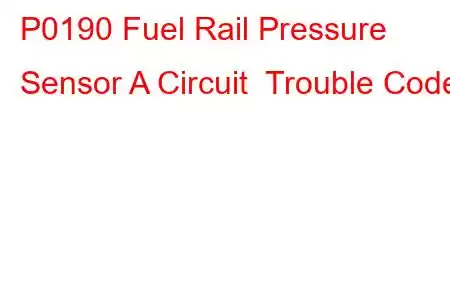P0190 Fuel Rail Pressure Sensor "A" Circuit
OBD-II Trouble Code Technical Description
Fuel Rail Pressure Sensor "A" Circuit
What does that mean?
This generic powertrain/engine diagnostic trouble code typically applies to most fuel injected engines, both gas and diesel since 2000. The code applies to all manufacturers such as Volvo, Ford, GMC, VW, etc.
This code is strictly concerned about the incoming signal from the fuel rail pressure (FRP) sensor falling below a calibrated limit for a calibrated amount of time. This can be a mechanical or an electrical circuit fault, depending upon vehicle manufacturer, fuel type and fuel system.
Troubleshooting steps may vary depending upon manufacturer, type of fuel rail pressure system, and type of fuel rail pressure sensor and wire colors.
Symptoms
Symptoms of a P0190 engine code may include:
Malfunction Indicator Lamp (MIL) illuminated Lack of power Engine cranks but won't startCauses
Potential causes for this code to set are:
VREF Open Circuit Damaged FRP sensor Excessive resistance in the VREF circuitDiagnostic and Repair Procedures
A good starting point is always to check for technical service bulletins (TSB) for your particular vehicle. Your issue may be a known issue with a known fix put out by the manufacturer and can save you time and money during diagnosis.
Next, locate Fuel Rail Pressure Sensor on your particular vehicle. It may look similar to this one:
Once located, visually inspect the connectors and wiring. Look for chafing, rubbing, bare wires, burn spots or melted plastic. Pull the connectors apart and carefully inspect the terminals (the metal parts) inside the connectors. See if they look corroded, burnt or possibly green in color versus the normal metal color you are probably used to seeing. You can get some Electrical Contact cleaner at any parts store if cleaning of the terminals is needed. If this is not possible, find some 91% rubbing alcohol and a light plastic bristle brush to clean them with. Afterwards let them air dry, get some dielectric silicone compound (same stuff they use for light bulb sockets and spark plug wires) and put some where the terminals come into contact.
If you have a scan tool, clear the diagnostic trouble codes from memory, and see if this code returns. If it does not, then the connections were most likely your problem.
If the code does return, we will need to test the sensor and its associated circuits. Typically there are 3 wires at the FRP sensor. Disconnect the harness going to the FRP Sensor. With a Digital Volt Ohm Meter (DVOM), test the 5V power supply circuit going to the sensor to insure it is being powered up (Red lead to the 5V power supply circuit, black lead to a good ground). If there is 12 volts to the sensor when there should be 5 volts, repair the wiring from the PCM to the sensor for a short to 12 volts, or possibly a bad PCM.
If that’s OK, with a DVOM, check to make sure you have 5V on the FRP Sensor signal circuit (Red lead to the sensor signal circuit, black lead to a good ground). If there is no 5 volts to the sensor, or if you see 12 volts to the sensor, repair the wiring from the PCM to the sensor, or once again a possible bad PCM.
If that’s OK, check to make sure you have a good ground at the FRP sensor. Connect a test light to 12V battery positive (red terminal) and touch the other end of the test light to the ground circuit going to the FRP Sensor circuit ground. If the test light does not light up, this would indicate the problem circuit. If it does light up, wiggle the wiring harness going to the FRP sensor to see if the test light flickers, indicating an intermittent connection.
If all tests have passed and you still get a code P0190, this would most likely indicate a failed PCM. A hard reset (battery disconnect) would reco
Read: 43


